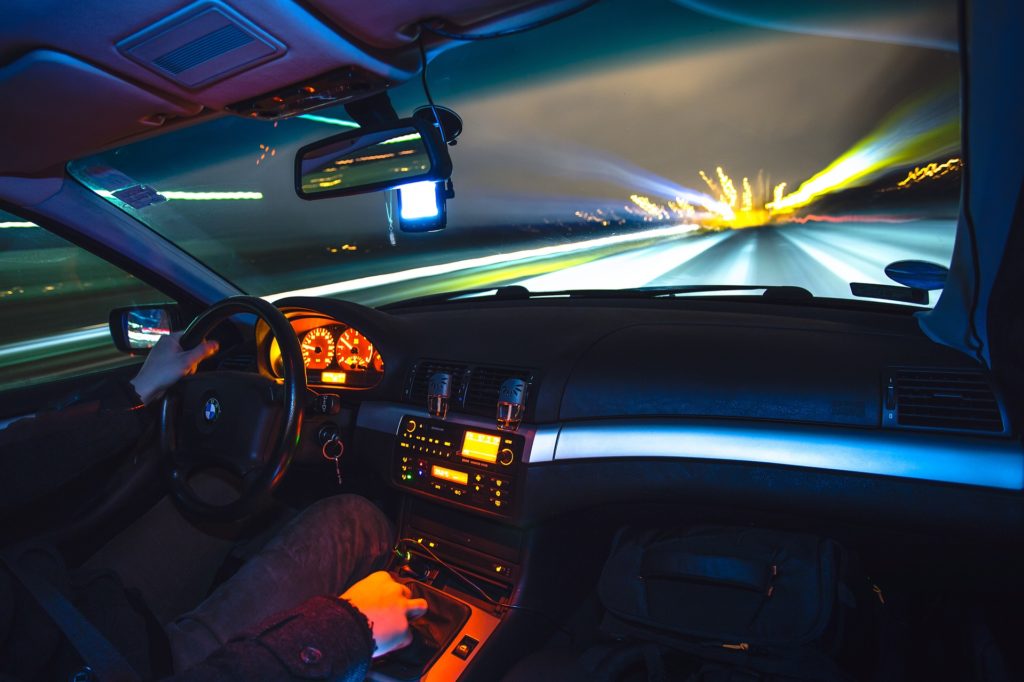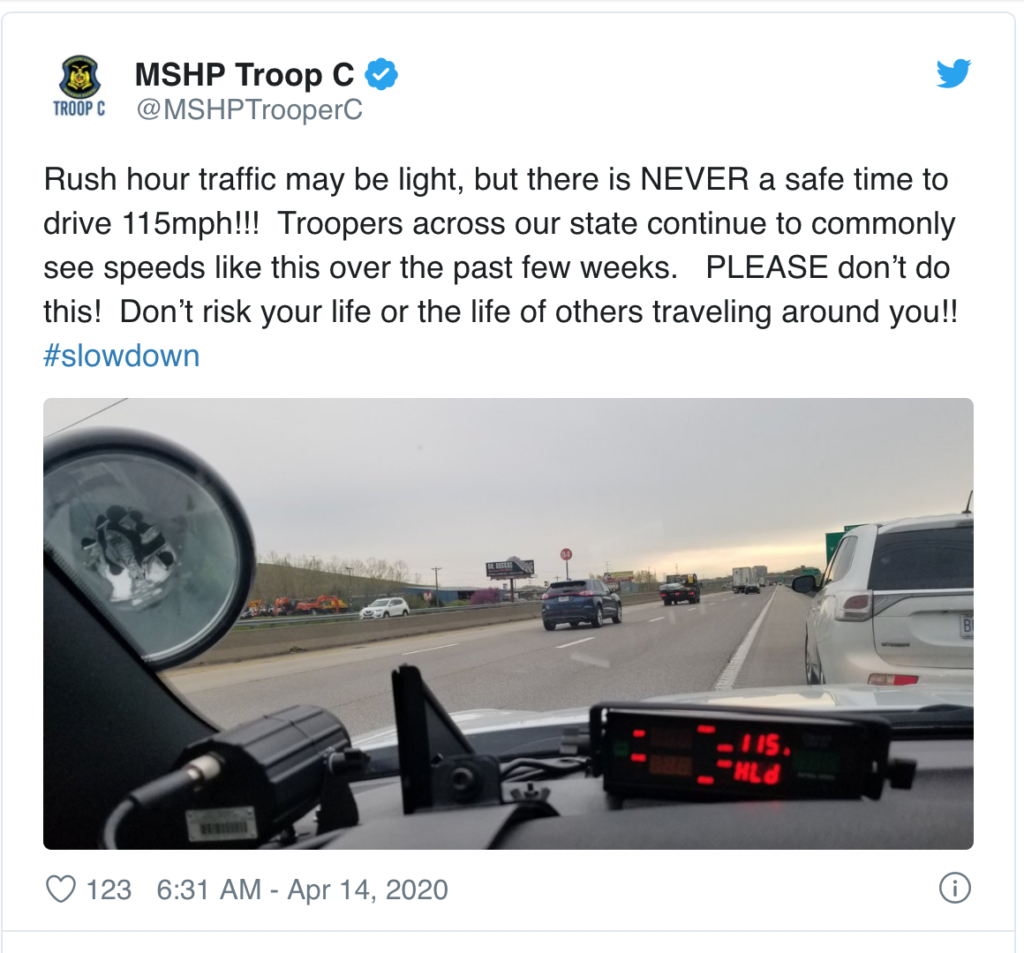By Jenni Bergal, Stateline

As Americans remain at home, many roads in cities, suburbs and rural areas are practically deserted. But the absence of traffic is a seductive draw for one type of driver: speeders.
“People are saying, ‘Wow, the roads are wide open. There’s no one here but me,’” said Pam Shadel Fischer, a senior director at the Governors Highway Safety Association, which represents state highway safety offices. “We’re seeing incredibly crazy, off-the-chart speed and aggressiveness.”
Daily vehicle traffic dropped by two-thirds nationally from March 1 through April 10, according to StreetLight Data, a San Francisco-based traffic analytics company.
And while many states, such as California and Ohio, have seen a reduction in overall crashes during the pandemic compared with last year, some are reporting a jump in traffic fatalities that they say is linked to speeding or reckless driving.
“It’s crazy. People are driving like idiots,” said Buffalo Grove (Illinois) Police Chief Steven Casstevens, president of the International Association of Chiefs of Police. “I’m on a tollway at least 15 miles as part of my own travel to work, and every morning I get passed by no less than 15 cars doing over 100 miles an hour.”
Some drivers figure police are so busy and strained dealing with COVID-19 that they’re not as focused on speeders.
That’s the case in Ohio, where speeding citations have plummeted at least in part because some troopers have been tasked with other missions such as humanitarian efforts, security details and assistance to local police agencies, said State Highway Patrol Lt. Craig Cvetan.
Drivers in some states also may be hearing that police departments have ordered officers not to make routine traffic stops so they can avoid unnecessary direct contact with motorists during the pandemic, highway safety officials say.
“People believe that because of the pandemic, police are not as engaged in doing traffic enforcement,” Fischer said. “But in many states, officers still are out there and if they’re seeing someone doing dangerous things, they’re going to stop them.”
In Iowa, where traffic is down about 50% even without a stay-at-home order, troopers cited 103 drivers for speeding 100 mph or higher in March, according to State Patrol Sgt. Alex Dinkla. That was up from 64 drivers in March 2019.
In New York City, speed cameras have issued almost twice as many tickets a day, as some drivers drag race down Manhattan streets.
In Marion County, Oregon, the sheriff’s department tweeted in late March that officers had stopped “multiple drivers” traveling at 90-plus mph in just one morning.
An officer in Thornton, Colorado, caught a motorist driving 128 mph in a 55 mph zone. “Let us just say, he is in a heap of trouble,” the police department tweeted.
And last week, the same day a highway patrol officer in western Missouri clocked a driver going 143 mph, troopers in the eastern part of the state were dealing with similar problems.
“Rush hour traffic may be light, but there is NEVER a safe time to drive 115mph!!!” tweeted the patrol’s Troop C office. “Troopers across our state continue to commonly see speeds like this over the past few weeks. PLEASE don’t do this!”

Higher Fatalities
Despite the deserted roads, some states are experiencing a spike in traffic deaths.
In Minnesota, where traffic volume has declined an average of 50%, there were 25 fatal crashes from March 16 through April 12. Last year, there were 17 during that period, said Mike Hanson, director of the state’s Office of Traffic Safety.
“Speeding is playing a huge part in this,” Hanson said. “And we’re seeing these crashes all across the state.”
In Missouri, where traffic has dropped more than 40%, officials had expected to see a big decrease in crash fatalities, said State Highway Patrol Capt. John Hotz. Instead, there have been 191 this year, as of April 13, compared with 189 during that period last year.
“We’re seeing cars routinely running in the 100-plus range. Our Twitter accounts are filled with high speeds we have seen across the state,” Hotz said. “We know the faster a vehicle is going when it crashes, the more severe that crash is going to be. You’re not going to be able to slow down or stop.”
Police and highway safety officials warn that motorists who are crashing because they are speeding or driving recklessly aren’t just putting themselves and other drivers at risk.
“We have enough stress on our hospitals and ERs right now with COVID-19. The message is: ‘Please don’t wind up there because you did something foolish behind the wheel,’” Fischer said. “Let’s give our health care workers a break.”
Changing Behavior
It’s too early to understand why some states are seeing a jump in traffic fatalities while others aren’t, even though many are reporting the same problems with speeders, highway safety experts say.
“We should be seeing the fatality numbers coming down everywhere,” Fischer said. “We don’t know why they’re not. We can’t explain it.”
Chuck Farmer, vice president of research at the Insurance Institute for Highway Safety, a nonprofit research group funded by auto insurance companies, said it’s something researchers will need to examine after the pandemic ends.
“It’s still really early data. In most cases, we’re talking about a couple of weeks, up to a month,” Farmer said. “I don’t think you can talk about a trend just yet.”
Farmer and Fischer agree that for now, the best way to address the problem of fatal high-speed crashes is to focus on sending a message to drivers.
“The only way to stop this is to change their attitude, which generally means making them think they’re going to get caught, that police are out there watching,” Farmer said. “Somehow we’ve got to stop them from going wild out there.”
Many police agencies have started sending out warnings to the public, reminding everyone that they’re still enforcing speed laws.
“We are seeing a rise in motorists traveling at excessive speeds in the #bayarea,” tweeted the California Highway Patrol. “We are still out in force and will continue to issue citations. There is no faster way to get a suspended license than driving 100mph+!”
“Laws exist, so do we,” tweeted the Lakewood (Colorado) Police Department.
Ultimately, Fischer said, it comes down to thinking of highway safety as a public health issue.
“This pandemic is about changing behavior. We can’t be in crowds. We have to maintain our distance and wash our hands,” she said. “Those are choices we are being asked to make to be safe and protect our families.
“It’s the same with traffic crashes. People are making choices that, in some cases, are really inappropriate. They’re hurting themselves and hurting others. They need to slow down, put their cellphones down and change their behavior.”
Stateline, an initiative of The Pew Charitable Trusts.


